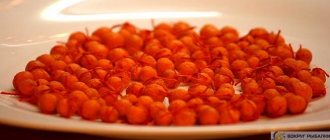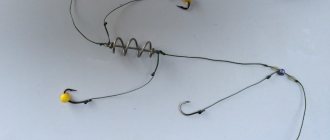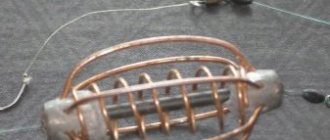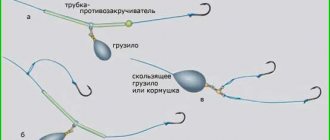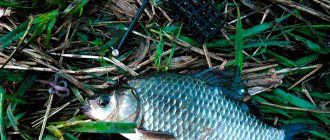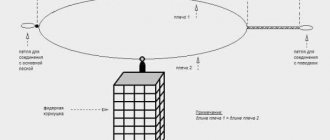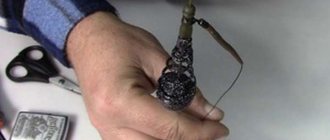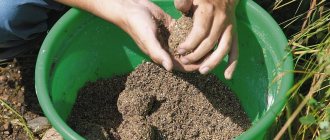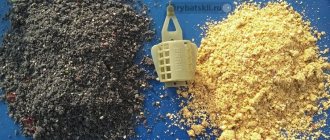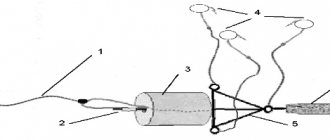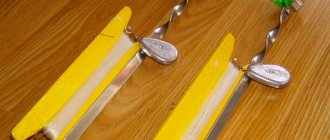Crucian carp is a fish of the carp family and lives almost everywhere throughout central Russia. Crucian carp feed on almost everything, from algae to worms and insects that have fallen into the water. The crucian carp that lives in the middle zone is usually medium-sized, but the crucian carp that lives in the lower reaches of the Volga sometimes reaches the size of a small carp. There are two varieties of crucian carp in the middle zone:
- Silver is not very large, covered with medium scales of light shades. Handles transportation well.
- Golden - slightly larger than silver, relatively large scales, yellow in shade. Does not tolerate transportation well.
Float tackle
Float tackle (or “float rod”) is perhaps the most popular and sporting tackle for catching crucian carp. and consists of a rod, reel, fishing line, the float itself, a sinker and a hook with a nozzle. Float (nuances of choice).
Since crucian carp is a capricious fish, you should choose the most sensitive float. The ideal option is a tube float, which is an oblong body with a line attachment at the lower end. Such floats have one drawback - it is difficult to select a sinker for them. If crucian carp is not the only purpose of fishing, you can take a heavier float. The fishing line should be taken from 0.12 to 0.16 mm. However, if there is a chance of a large fish biting, the diameter can be increased to 0.2 - 0.25 mm. The shade of the fishing line does not play a special role, but it is preferable to use blue-green shades.
The hook should be taken No. 5-7 according to the domestic classification (6 – 10 according to the international classification). It is easy to distinguish between classifications: in the domestic one, the hook number is directly proportional to its size, in the international one - vice versa). As a nozzle you can use bread, maggot, worm, dough.
How to catch crucian carp with a float - read in this guide.
Feeder tackle
The feeder rod (detailed article on how to choose) should be chosen depending on the conditions (reservoir, weather).
So, for large bodies of water with strong currents (rivers, reservoirs), a tackle with a large rod weight of up to 120 g is suitable. For small bodies of water, a tackle with a rod up to 60 g and a small feeder is suitable. Rods with a length of 3.5 - 4 meters are the most versatile and have a good price-quality ratio. When choosing a feeder, you should take products weighing slightly less than the test rod, since the rest of the weight will be “taken” by the bait. The bait should also correspond to the reservoir (recipes for crucian carp bait). When fishing on a body of water with a strong current, the bait should be dense enough so that it does not wash away, and on reservoirs with a weak current or standing water - as light as possible so that it does not sink in the muddy bottom. For the latter option, a base of breadcrumbs is suitable.
To prevent the fish from quickly getting enough and thus losing interest in the bait, the components of the bait must be small. Crucian carp do not have specific taste preferences, so there can be no unambiguous and clear advice on how to make bait. For scent, you can add a little grated garlic, ground seeds, vegetable oil or even ground cookies to the bait.
Baits. As with bait, there is no advice on what to fish with. The taste preferences of crucian carp can change even during the day. We can only say that crucian carp bite well on pearl barley, pasta, corn, pancakes, and rye bread dough flavored with garlic.
A fishing line with a cross section of 0.12 mm is suitable. If there is a chance of carp or other strong fish biting, it is better to take a fishing line of about 0.2 mm. The leash should be made in this case from a thinner fishing line. The nozzle should be such that small things like roach or bleak cannot swallow it. It is better to use hooks from No. 5 – 7 to No. 9. The latter is suitable for large crucian carp. Also, the hooks should be as sharp as possible, otherwise there may be problems with hooking fish.
Tops (quivertips) , like other tackle, should be selected depending on the conditions. In the current and in the wind, the tip should not be very sensitive so as not to react to these factors and not create false bites. When fishing on a still body of water in calm weather, it should be more sensitive so that the angler can see even the most sluggish bite.
The simplest equipment for crucian carp is a paternoster.
The technique of catching crucian carp with a feeder is described in the corresponding article on our website.
Features of the choice of leashes, sinkers and hooks
It is best if the leashes are made of thinner wood than the main one. The most important thing is to determine the appropriate length of the leashes. Most types of leashes are suitable for leashes up to 50 cm long, this prevents them from getting tangled with each other. A length of about 1 meter is used only when fishing with live bait. The diameter of the leashes is selected from 0.15 to 0.25 mm, depending on the fish being caught.
Choosing the right sinker is no less important than choosing the fishing line. When fishing in a current, use a flat weight that will not roll due to the movement of water masses. If fishing is carried out without a feeder, the weight of the sinker should not exceed 10-12 grams, but in strong currents the weight can be increased up to 50 grams inclusive.
The most popular forms of sinkers:
- Flat;
- Oval;
- Triangular;
- Diamond-shaped.
Figure 8. Pay attention to such points as the choice of fishing line, hooks and sinkers
Hooks are selected based on the expected size and weight of the fish, as well as the size of the bait. They must be sharp and strong enough to support the weight of bait and fish (Figure 8). The larger the fish, the thicker the hook wire should be. For catching crucian carp, hooks with the sting bent inward are best suited; it is much more difficult for it to slip off.
Tips for catching crucian carp on a donk:
- Before you start fishing from the shore, find a suitable place for yourself that is easy to clear so that you have a place to lay out and untangle the fishing line;
- For greater efficiency, you can use different types of bait for each leash (for example, dough, maggot and a piece of cake);
- To increase the bite, you can additionally roll up bread balls and throw them next to the hooks, this will help attract crucian carp faster.
From all of the above, we can conclude that the donka can be a universal tackle not only for catching crucian carp. It has a large number of advantages, and it is quite easy to do it yourself, even for a novice fisherman. The main thing is to follow certain rules and take into account the characteristics of the reservoir and the fish that will be caught.
Good luck to you and have a great bite!
Makushatnik
A makushatnik is a special tackle for fishing using cake.
Usually carp are caught with it, but sometimes crucian carp is also caught with it. In view of this, it is possible to catch crucian carp with it purposefully. Fishing for crucian carp on top has several features. Bottom fishing rods from a spinning rod are often used as gear, but more professional fishermen use feeders.
- You can use a crucian carp bait together with makukha – the most commonly used are worms and granules. Worms can be used either as dung or crawling worms, which can be found in the city or bought at a fishing store, or as “shore” worms, which can be obtained directly on the spot. Granules are used in anise, dill, hemp, corn, raspberry or strawberry flavors. The granules are placed two per hook.
- You can also use regular carp rigging, hooks can either be placed in the cake or left free. You can buy the cake flavored or flavor it yourself. Anise, hemp, dill and strawberries are suitable.
Nipple tackle
Almost all types of spinning tackle are suitable for this method of fishing: any reels and fishing lines with a cross-section of up to 0.6 mm.
Viscous bait is stuffed into the feeder and hooks are stuck into it. “Millet dough” can be used as bait, as well as bait. To do this, the millet is steamed in a water bath and then rolled out like dough. Then add semolina or special bait. You can also use a mixture of ground white and black bread pulp and boiled potatoes. This nozzle should have a consistency similar to plasticine. You can also use rolled oats. The attachment must last for at least 10 hours.
This method, although effective, is unsportsmanlike. A self-hatched fish is pulled out of the reservoir. In addition, it takes quite a long time before the bite occurs, unlike with feeder gear. Read the feeder guide for beginners and understand all the delights of sports feeder fishing.
Spring
A spring is an analogue of a nipple, but viscous bait is used on a spring rig. The leash to the feeder is made of a cord, since, unlike monofilament, it has no memory. The length of the leash is 5–7 cm. The hooks are left open, and a foam ball is put on the hooks themselves, the size of which is selected to fit the hook. It is best if the lifting force of the ball balances the weight of the hook, so it will be, as it were, suspended in the water and will sway as it vibrates within the layers.
Of the other characteristics, only the weight of the feeder is of significant importance. The larger it is, the greater the likelihood of self-hooking. This tackle is also unsportsmanlike, since the fish are hooked due to the inertia and weight of the feeder.
Rubber
An elastic band is a bottom tackle that has a piece of aircraft model rubber as a shock absorber. We have a detailed article about this type of fishing. When pulling the fishing line out of the water, the elastic band stretches, this saves time on “reloading”, since there is no need to cast the tackle again, thereby scaring away the fish. The sinker must be taken heavy so that the elastic does not pull it out of the water when stretched.
To determine the bite, use a guard or use coastal vegetation instead. Bread, corn, worms or dough are used as bait for crucian carp. This tackle can be left overnight, and in the dark the likelihood of a bite increases. It is not recommended to leave the gear overnight if the trip is not overnight or if the house is far from the reservoir.
primanki.com
What are the pros and cons of the “crucian carp killer”?
The advantages of this gear include the following:
- The proximity of bait and bait significantly increases the chance that the crucian carp will find the latter.
- Several feeders located on the gear allow you to fish a large area .
- There is a high probability of self-hooking - the fisherman can only pull the crucian carp out of the water.
- It is possible to use several baits and baits at the same time - therefore, choosing the most effective one .
- This tackle allows you to catch crucian carp even in relatively bad weather conditions .
- You can make a crucian carp killer yourself with certain skills.
However, there are also disadvantages to this gear:
- A fairly loud splash of water when casting will scare the crucian carp away from the fishing spot for a while.
- Quite a lot of skill when casting a tackle consisting of several feeders - they can easily get tangled with each other.
- In terms of sensitivity to bites, the “crucian carp killer” is inferior to the same single feeder. However, frequent cases of self-cutting help out.
How to catch crucian carp with a feeder
Installation of equipment for catching crucian carp depends on where the fishing will take place (in which body of water), as well as on the place of fishing - at the bottom or in the water column.
Fishermen most often use bottom tackle, since crucian carp likes to swim at depth. For fishing, it is better to choose a feeder rod; the equipment of the bottom rod includes the following components:
- rod;
- spinning reel;
- monofilament line;
- hooks;
- bottom rigs.
A float fishing rod with a feeder is often used, the equipment of which includes a weight, an elastic band, a nylon cord, a swivel (hinge, fastening), a fishing line, and a feeder.
When fishing to catch crucian carp, it is recommended to use bait: you can buy it in a store or prepare it yourself. Spices are often used as ready-made bait: vanilla, anise, garlic. Many fishermen prefer to prepare their own bait. To prepare it, you can use cookies, breadcrumbs, oatmeal, pearl barley and sunflower seeds. A hungry fish will actively swim to the feeding area, which will increase the chance of being caught.
Equipment depends on the time of year. For spring fishing, float and light feeder gear are used. In the summer heat, a crucian carp killer is indispensable, in the fall - feeder tackle, and in winter, jigs should be used. Taking into account the seasonal behavior of the fish, its activity, using bait and choosing the right gear, you can ensure a large catch.
Bait and attachments for crucian carp killer tackle
The success of catching crucian carp with killer bait largely depends on properly prepared bait and its consistency. After casting, the bait should not fall apart into small pieces and spill out from the feeder. To do this, its consistency must be sufficiently viscous and thick . For this, various boiled porridges with flavorings , to which oatmeal .
Some fishermen mix the bait so thick that its consistency becomes closer to plasticine or resembles a very thick dough . Ultimately, the spring with bait is more like a pacifier - the inability to reach the bait, which is very close, only activates the crucian carp to bite on the bait with a hook.
As bait, you can use the entire range of baits for crucian carp - both animal and plant origin - maggots, worms, bread and even pieces of foam.
Using baits and baits
For fishing using a nipple, you can use almost any bait that can interest peaceful fish. Among them:
- A maggot or blowfly larva with a characteristic white body color. Most often, this bait is taken for catching crucian carp, as it demonstrates good performance throughout the summer period. To successfully deliver the creature to a pond, find a glass jar in advance, place several larvae in it and cover the container with a damp cloth. Try to protect it from contact with direct sunlight, otherwise it will lead to their death.
- Bloodworm. It is characterized by many delicious qualities, but it is especially interesting to fish for it only in the spring, since in the summer most species of peaceful fish switch to plant foods. Fishermen treat bait with special respect because of its beautiful game and specific smell, which attracts even the laziest prey.
- Earthworm. Demonstrates excellent efficiency almost all summer. To ensure successful fishing, you should choose large-sized earthworms. Their lifespan is very long, and for storage it is enough to take a rag bag, put a little damp earth there, and then the bait itself. Iron cans are not suitable for this purpose.
- Semolina chatter. A highly effective attachment, however, it does not work in every body of water. Bread pellets, which are created on the basis of Borodino bread, with a characteristic aroma, are famous for a similar effect.
There are several types of donks for catching crucian carp:
- Donka on a reel
The simplest (oldest) donka, which can be used in all types of reservoirs, with the exception of those in which the silt layer exceeds 25 cm. Consists of the following elements:- main line (section from 0.2 mm)
leashes (length up to 30 cm, cross-section up to 0.14 mm)
- hooks (No. 14 - No. 8 according to the European classification)
- sinkers
- Donka with a shock absorber, which is used on reservoirs with a flat, preferably hard, bottom. Consists of the following elements:
- main line (section from 0.2 mm)
- leashes (length up to 30 cm, cross-section up to 0.14 mm)
- hooks (No. 14 - No. 8 according to the European classification)
- rubber shock absorber (section up to 5 mm)
- sinkers
- Donka with a feeder (including feeder tackle), which can be used on all types of reservoirs and consists of the following elements:
- main line (section from 0.2 mm)
- leashes (length from 10 cm to 1 m, cross-section up to 0.14 mm)
- hooks (No. 14 - No. 8 according to the European classification)
- feeders (various weights and body shapes)
Currently, a modern donka is understood as tackle that includes:
- a fishing rod (specialized, standard with guides or a spinning rod) equipped with a bite alarm;
- reel with fishing line;
- a feeder equipped with a built-in sinker and hook(s).
Mechanical and electronic equipment can be used as a bite alarm. Mechanical ones include a quiver in feeder and picker rigs, and a bell.
In each tackle, you can use an anti-twist tube to connect the leads with the main line and the swivel.
The feeder can be plastic or made of metal. Container type or frame. The first type is used mainly either for feeder fishing or for feeding with animal bait. Method type frame feeders are gear for catching large crucian carp or carp mainly on the silted bottom.
For bottom fishing for crucian carp on rivers, all types of bottoms are used, including feeder equipment. On the river, you can use coarser tackle, increasing the thickness of the main line to 0.25 mm and the length of the leads to 1 meter in rigs without a feeder. When using the last element of the equipment, filled with porridge, the length of the leash can remain the same (up to 10 cm)
Most rigs with a feeder are distinguished by the shape of the feeder, which can have:
- Cylindrical shape. Such feeders are good to use on ponds without a current with a hard bottom.
- The shape of a parallelepiped with a square cross-section, which is used in feeder fishing in reservoirs both with and without current.
- The shape of a parallelepiped with a triangular cross-section. Such feeders are used in reservoirs with strong underwater currents.
- The shape of a spindle, which is most often used in reservoirs without a current.
Plastic feeders may have:
- spindle-shaped;
- cylindrical.
By definition, they have less weight, so they can be used mainly in calm water.
To catch crucian carp in calm water bodies, you can use:
- any metal feeders, if the bottom of this reservoir is hard;
- any plastic feeders, especially if the bottom is heavily silted;
On such reservoirs you need to use the thinnest possible main line and inconspicuous leashes, which are always shorter than “river” ones.
Bait is of little importance in choosing gear:
- In any case, first of all, the hook must be suitable for the bait.
- Delicate baits require greater sensitivity of the bite alarm.
In the spring before spawning, it is good to use feeder equipment to catch crucian carp. After spawning, feeder fishing becomes the main method, primarily on rivers. On bodies of calm water, spindle-shaped feeders (“spring”), “plugs,” and “nipples” work well. Closer to autumn, all types of donks can be used on reservoirs of all types.
Fishing technique
Before fishing with a “crucian carp killer” tackle, you should thoroughly examine the bottom of the reservoir and mark the most promising places - edges, holes, depressions at the bottom. If possible, it is better to do a preliminary starting feeding .
It is recommended to cast to the same place , since crucian carp responds well to bait. To do this, you should select a landmark on the opposite bank of the reservoir, and you can use a clip attached to the fishing line as a casting range limiter .
Since this tackle is quite heavy , its casting is carried out gently, avoiding sudden jerks . Immediately before the moment it falls into the water, when all the fishing line is exhausted, the rod should be moved a little forward . When the tackle falls to the bottom - this is determined by the weakening of the fishing line, it needs to be tightened a little .
It is best to secure the rod in a vertical position on a special stand - this will make it easier to track the bite of a crucian carp.
The characteristic bite of crucian carp on this tackle is a quick jerk , followed by sagging of the fishing line. At this moment you need to cut .
If there are no bites, it is recommended to re-throw the tackle approximately every 20 minutes .
Nuances of fishing depending on the time of year
Each season of the year - spring, summer, autumn - is characterized by its own characteristics of bottom fishing with the “crucian carp killer” tackle.
Spring
In spring, it is recommended to use small-fraction complementary foods . To do this, you can grind the porridge in a coffee grinder. Vegetable baits with the addition of chopped bloodworms also perform well at this time .
Many fishermen do not advise getting carried away when fishing for crucian carp in the spring by adding flavoring additives .
Also at this time of year it is recommended a little sifted soil to the complementary food . In this case, it is best to use one collected on the shore of the reservoir in which you plan to fish for crucian carp.
At the very beginning of the spring period, crucian carp will be relatively inactive . The best bite can be expected from mid-spring . After the water warms up, the active bite of crucian carp will last only a few weeks , after which the spawning period will begin and the bite will stop .
- Secrets of fishing for crucian carp in spring
- Fishing for crucian carp in May
Summer
In summer, it is better to add flavorings - honey, vanilla. During this period, crucian carp prefers plant baits . The desired ingredients in complementary foods at this time are fried sunflower seeds, breadcrumbs, semolina, oatmeal, and milk powder.
In the summer, crucian carp go well with additional bait , but you need to be careful not to get carried away and not to overfeed the fish. The best bite is observed at sunset and sunrise . And only on warm (but not hot) calm , quiet days can you expect a crucian bite throughout the day .
Autumn
In autumn crucian carp are more attracted to animal bait , so it is better to add chopped bloodworms, aquarium animal food, and dried daphnia to complementary food.
When the water temperature drops from mid-October crucian carp becomes less active , so there is no point in using a large amount of additional food . However, crucian carp can bite at this time throughout the day .
Features of gear for carp fishing
Carp is such an experienced opponent that catching it requires making the most of all your knowledge in order to deceive and lure the cunning fish. Being an omnivore, it is not easy to catch because it will give preference to the best food and will never swim close if the shadow of a fisherman is visible.
Carp is a species that feeds only in the morning and at sunset, and hides in holes the rest of the time. Individuals swimming individually are rare; as a rule, they stay in a flock. The fish is very heat-loving , so in cold water it is sluggish when it comes to food. At first after birth, he is afraid of pike, however, later, due to his size, this fear disappears.
One likely habitat is flooded meadows, as it is attracted to bodies of water with grassy areas .
Bite depending on seasonality
1. Winter fishing is sluggish due to cold water, which carp do not like. However, there is a chance of catching, given its weak resistance and lethargy.
2. Spring – the beginning of active actions of fish, which need to gain weight after winter exhaustion.
3. Summer is the perfect time. It is better to fish in deep places where the fish hide from the heat of the day.
4. In autumn, fishing activity decreases and fishing becomes more difficult, with the exception of warm days.
Other variations of the crucian carp killer tackle
- Killer of crucian carp with a blind rig . In appearance, this version of the tackle is somewhat reminiscent of a garland . All three feeders on the fishing line are securely fixed using locking beads. In order to avoid tangling of the tackle when casting, an additional weight , which should have a greater mass than the feeders filled with bait. When casting, it will tighten the line and prevent the feeders from getting tangled with each other. The length of the leashes is recommended to be about 4 cm .
- Crucian carp killer with a floating rig . In this version of the gear, not three, but one feeder . It will also serve as a load . Sliding along the fishing line is limited by stop beads . At the end of the rig, leashes , which, to avoid tangling, can be equipped with a so-called “yoke” - small antennae made of thin wire.
DIY “Crucian Killer”
Ready-made “crucian carp killer” tackle is not uncommon on the market , but if you wish, you can make it yourself at home .
Gear selection
The following gear is used to make a crucian carp killer :
- Lead weight with a small eyelet. Usually a load weighing from 30 to 50 g is taken.
- Swivel equipped with a clasp.
- Carp hooks with a short shank. They are selected based on the size of the expected fish, but you should not take too large ones. You should not take more than 5 hooks per feeder - in this case they will only get tangled and complicate handling of the tackle.
- Three springy feeders without additional loading. It would be good if the springs were equipped with a hollow tube for stringing them onto a cord. This will greatly simplify the production of gear. If it is not there, the feeder should be secured with knots on the cord.
- Thin cord or fishing line for leashes with a diameter of 0.2 - 0.3 mm.
- Stop beads.
Gear manufacturing process
We prepare several leashes from thin fishing line approximately 4-7 cm . a loop at the end of the leashes - with its help it will be more convenient to secure the leash to the feeder.
We take a skein of the main cord (you can also take a thick fishing line) and cut about 0.8 m from it. You can also use regular nylon rope. At the end of the cord we knit a loop with a figure-of-eight knot of such diameter that the lead weight can easily pass through it.
The lead weight will be tied “loop to loop”. To do this, a folded loop at the end of the cord is inserted into the hole at the end of the weight , and then the loop is thrown over the weight. The result is an inextricable connection .
We step back from the weight at a distance of about ten centimeters and knit a stop knot .
Next, we put a stop bead and pull it directly to the knot .
the first feeder on the cord , and behind it the second bead .
We knit near the second bead . Ideally, it should be as close as possible to the feeder - it should be firmly fixed and not freely “walk” along the cord.
Next, about 10 cm from the node securing the first feeder and install the second and third feeders .
From the knot securing the last feeder , we retreat to a distance of 10 to 15 cm and knit a swivel , for which the tackle will be attached to the main fishing line.
Now you need to secure the leashes . They can be attached directly to the feeder itself , or they can be tied to a cord between the knot on it and the stop bead - it doesn’t matter. The main thing is that the leash does not float on the cord .
We tie the last leash - the “crucian carp killer” rig is ready!
What you need to know when installing gear
- Do not tie unnecessary knots when installing the tackle. That is why for beginners to try their hand at the “crucian carp killer” for the first time in a sliding version .
- Do not make leashes that are too long . Ideally, they may simply not reach each other . This will prevent them from being confused with each other. The maximum length of the leash is 7 cm .
- For leashes, braided cord than monofilament, as it is more elastic , and as a result, it is easier for crucian carp to swallow the hook. Also, with the same diameter, the cord has higher strength than fishing line.
- The weight at the end of the rig must be heavier than the feeder filled with bait, otherwise the rig will become very tangled when casting - the heaviest element on the entire rig will receive the greatest acceleration
- When installing, you should not use stopper beads that are too bright - they will not attract, but will scare away the approaching crucian carp .
How to make a feeder with your own hands for the “crucian carp killer”
If you do not have a ready-made feeder for equipment, you can also make it yourself at home.
To make it you will need thin soft iron wire with a diameter of 1 to 2.5 mm . It should be wound around a thick screwdriver or other object of suitable diameter - approximately 10-15 turns . After this, the excess wire is bitten off is given the appropriate shape using pliers - to do this, you need to increase the diameter of the rings in the middle of the spring and compress them at the edges.
The next step is to secure a hollow plastic tube inside the spring, through which the fishing line will be threaded when installing the gear. improvised means are also quite suitable - for example, a hollow, scribbled refill from a fountain pen.
In order to securely fasten it inside the feeder spring, it is enough to crimp it with wire . Two or three turns will be enough for this .
If you wish, you can also make so-called “hats” at the end of the tube in order to better fix the tube - to do this, heat its edges with a lighter and flatten it a little with an object with a flat surface.
Options for improving gear
A significant problem when fishing is the low sensitivity of the gear. However, this problem can be partially mitigated by doing the following:
- The weight attached to the end of the tackle should be moved away from the last feeder - at least at a distance of 0.5 m , and not attached directly behind it. It would also be better to select the load individually , based on the characteristics of the reservoir in which you plan to catch crucian carp - in still water you can use a load weighing about 30 g, but in reservoirs with strong currents you should increase its weight up to 150 - 200 g.
- Install sliding stop beads , with which you can slightly change the position of the feeder. The beads should slide between the locking nodes . The approximate stroke of the feeder can be about 10-15 cm .
- Sometimes it is advisable to install a fourth feeder on one tackle. Of course, casting will be more difficult , but in reservoirs with a small number of large crucian carp this will increase the chances of catching .
- If the bottom of the reservoir in which you catch crucian carp with this tackle is rocky , and the stones have sharp edges, this will lead to rapid wear of the braided fishing line. Therefore, to save money, monofilament rather than braid as the main fishing line .
- At first, it is better to use a different bait on each of the three feeders - this will allow you to choose the one that the crucian carp currently prefers. And only after you are convinced of the advantage of any one bait, you can use it on all feeders .
“Crucian carp killer” is an excellent tackle for catching a large specimen of crucian carp in a reservoir, because at great depths it will not be disturbed by small crucian carp. It is also good because it can be made even at home .
Choosing feeder equipment for fishing
When catching crucian carp on a feeder, the choice of one or another feeder equipment depends on the fishing conditions and the intensity of the fish’s bite:
- When fishing for crucian carp in shallow reservoirs with a muddy bottom, it is best to use paternoster and Gardner loop rigs.
- If the crucian carp is inactive and its bites are weak and barely noticeable, then it is better to use more sensitive equipment - an asymmetrical and symmetrical loop.
- The crucian killer tackle catches active fish well when fishing in small shallow water bodies with a depth of up to 2 meters.
There is no float for feeder fishing.
Line selection
When fishing for crucian carp at short distances, a strong monofilament line with a cross-section of 0.2-0.3 mm is most often used.
When fishing in large bodies of water, where the equipment is cast over long distances, a durable and inextensible braided cord with a thickness of 0.1-0.16 mm is more preferable.
Coil selection
Daiwa Infinity-X 5500BR
One of the best feeder reels. Thanks to the small-profile spool, the side of which is made of wear-resistant titanium coated with metal ceramics, the reel is able to accommodate a sufficient supply of fishing line or braided cord and cast it well, thereby ensuring long casts. The reel is equipped with 5 reliable bearings, a convenient and easy to switch baitrunner. All reel parts have an anti-corrosion protective layer.
Shimano Catana 2500 FC
Thanks to the line control system, the reel has a smooth run and winds the line in even turns, is equipped with 3 bearings (2 ball and 1 roller), and a front clutch. In addition, the model is equipped with a reliable system that blocks the reverse rotation of the spool.
In addition to the capacious aluminum reel used for braided cord, the reel also comes with a durable graphite spool for monofilament fishing line.
Ryobi ECUSIMA 3000
A powerful and durable reel that successfully competes with more famous brands in terms of quality, while being more affordable.
The reel body is made of light and durable alloy, the internal mechanisms are balanced, the reel is equipped with 5 bearings, a reliable and finely adjustable front clutch, and a spacious metal spool.
Ryobi ECUSIMA 3000 Daiwa Infinity-X 5500BR Shimano Catana 2500 FC
Leash
For feeder fishing for crucian carp, a leash is important. An incorrectly selected length and cross-section of this element of the tackle can lead to the loss of large fish and frequent breaks of the leash with weak hooks.
- For catching crucian carp, high-quality and durable monofilament fishing line with a cross-section of 0.14-0.18 mm is most often used.
- The length of the leash is chosen depending on the type of equipment used and it ranges from 40 to 80 cm.
- When choosing the length, it is important to take into account the possibility of a very long leash catching when casting behind a feeder, bushes, or ground.
Hooks
The size of the hook for the feeder depends both on the size of the fish and on what kind of bait you plan to use
When catching large crucian carp and using worms as bait, large hooks No. 10-12 with a long shank are used.
If corn, peas, or undercooked potatoes are used as bait, then use smaller hooks No. 14-16.
Among the huge range of hooks used for feeder fishing, the following models are the most reliable:
Mustad Nickel Bream Feeder 60332N/LP54 Owner cut chinu
Owner iseama 50046
Feeder
All feeder feeders can be divided into several types depending on their design features, load, and area of application.
Mesh feeders, or as they are often called “cages,” are the most common feeder feeders today. The design is a mesh frame with a fixed lead weighting plate.
According to the cross-sectional shape, such feeders are:
- Square;
- Rectangular;
- Round;
- Triangular.
Round feeders hold the bottom more effectively when fishing in still water and in weak currents; square, triangular and rectangular feeders, due to the large area of contact with the bottom soil, are more suitable for fishing in medium and strong currents.
In addition to the shape and weight of the weighting material, mesh feeders differ in the degree of leaching of the feed mixture in an abandoned feeder. According to this feature they are:
- Open - there are no partitions in the feeder and when the feeder hits the bottom, the bait spills out freely through the ends. Such feeders are used when fishing in still water.
- Semi-closed - the end opposite to the one on which the feeder mount is mounted is covered with a plastic partition. As a result, the bait does not spill out of the feeder, but is washed away by the current, forming a feeding path. Used during currents.
- In addition to mesh feeders, there are also spiral (“springs”) - a hollow rod with a wire spiral wound in a spindle-shaped manner. Such feeders are not weighted; they are located quite freely on the fishing line, moving between the stop bead and the swivel or lower leash assembly. They are used due to the lack of additional weight for fishing in still water.
A little information
“Crucian carp killer” is a non-sporting version of the equipment, similar to a feeder and a “pacifier”. It is believed that such a design was first made in England, from where fishermen from other countries learned about it. In short, as a rule, this gear consists of several feeders, which can have either sliding or blind mounting, and short leashes with hooks. The distance between the feeders is most often about 10 cm. The length of the leashes does not exceed 4-7 cm.
Not every feeder is suitable for such gear. An excellent option is an oval-shaped spring, where the turns of the wire are maximized towards its middle.
Also, the feeder must have a winding tube for passing the fishing line. This simplifies the installation of equipment and allows you to assemble more reliable equipment.
The number of feeders can vary from one to five. It's optimal when there are three of them. They are all stuffed with bait. Not necessarily purchased. Also suitable:
- mastyrka;
- dough;
- hominy;
- boiled porridge;
- flavored potatoes;
- cake and many others etc.
It is best to use the “killer” together with a feeder rod equipped with a spinning reel. There is often no need to react to a bite at all. After all, due to the heavy equipment, the fish hooks itself.
As bait you can use worms, maggots, bloodworms, corn, boilies and many others. other things that crucian carp like to eat. If viscous and thick bait is stuffed into the feeders, then you can take foam balls as bait. At the same time, some fishermen even hide the hooks inside the feeder, quickly converting the tackle into a “pacifier”.
"Crucian Killer" can be purchased at a fishing store. However, it is much better to assemble it yourself. After all, making this equipment yourself allows you to make it more informative and sensitive.
Nozzles in the feeder for crucian carp
As you know, crucian carp can bite on many baits, so to catch it you can use:
- worms;
- maggots;
- barley;
- corn;
- boilies;
- dough.
As a rule, a large number of fishermen use combined baits (barley + worms; corn + potatoes) to catch this fish, which work well under different fishing conditions and actively attract the attention of the fish.
The secret to a good catch has been revealed, just pour 1/4 of a slice into the water...
Standard version of the “crucian carp killer”
- To assemble the “crucian carp killer” you will need a monofilament line with a thickness of 0.3 to 0.4 mm or a braided cord with a slightly smaller cross-section and a length of 80-100 cm. Fluorocarbon fishing line is also a good option. Some even use a nylon cord. However, it makes the equipment too noticeable, although it is more durable.
- We attach a reliable carabiner fastener to one end of the fishing line or cord to attach the load, and also, if necessary, quickly change it to a lighter or heavier option.
- After that, spring feeders are inserted onto the fishing line through a special tube built inside each one. Now you need to fix them at a distance of 10-15 cm from each other. You can completely limit their movement with stoppers by installing them end-to-end on both sides. If you want to make the tackle more sensitive, then place the stoppers at a short distance (2-3 cm) from each feeder.
- The next step is to install the leashes. Their length is approximately 5 cm. If they are larger, they may get confused with other elements of the equipment. The leashes must be tied directly to the feeder (by some coil of the spring).
- All that remains is to install a swivel with a clasp on the other end of the fishing line.
With this DIY installation option, you don’t have to use a weight at the end of the fishing line. It is enough to install feeders with internal loading. They are easy to find in any fishing store.
The outermost feeder should be heavier than the others. Otherwise, the equipment will constantly get tangled when casting and immersing in water.
The best tackle for crucian carp
Nowadays, crucian carp are increasingly caught using gear with a feeder. This method has a number of advantages:
- When it is formed, rather large hooks are usually placed, which makes it possible to catch only adult individuals.
- A variety of baits allow you to maximize your catch size.
- Efficient in any weather.
Anglers who used the feeder for the first time give the following reviews:
“A very effective way to catch large crucian and medium carp. The good news is that little things don’t spoil the overall picture.” Grade:
“I saw an interesting piece of equipment from a friend. I made the same one for myself. I recommend!"
Grade:
“I was very pleased with the equipment with feeders. I didn’t even see a bite on the float, the feeders saved me.” Grade:
There are several effective types of equipment for catching crucian carp, here are the most popular of them:
- "float";
- "crucian carp killer";
- "not lost";
- "makushatnik";
- "pacifier";
- "spring";
- "rubber".
Float tackle for crucian carp is divided into two types:
- the blind one is made on a fly rod 4-6 meters long. The float is attached to the fishing line along with a clamping weight under it. Next, a leash with a hook is knitted. The float should be placed sensitively, because the bite of crucian carp can be very sluggish.
- Sliding tackle is usually designed for long casting. It uses a sliding float with a large load, which is locked with rubber stops. With their help, the depth at which the hook with bait will be placed is also adjusted.
Tackle “Crucian carp killer”
This gear is quite common among fishermen. It consists of:
- 1-4 feeders (they can be of different sizes);
- leashes with hooks;
- load 10-50 g.
Typically, such equipment is assembled onto a cord or “steel” with a diameter of up to 0.3 mm. Beads or stoppers are additionally placed between the feeders to avoid the hooks from tangling with each other. Leashes with hooks are tied directly above the feeders.
The load must be at the bottom. It is better to take a drop-shaped sinker on a swivel, this will avoid the tackle getting tangled when casting. The finished tackle is attached to the main line through a swivel.
Catch tackle "Nepropadushka"
This gear is completely homemade. It is made from the simplest materials that any fisherman can find on his farm.
“Non-Prolapse” consists of:
- homemade feeder;
- leashes;
- hooks
You need to make the feeder yourself. This is done quite easily. On a piece of wire, 1 mm thick and up to 30 cm long, on one side, using pliers, we make a small eye. After 3-4 cm we bend another ear. Next, we insert the resulting rings into a hollow tube; the body of a ballpoint pen is ideal.
Then we begin to wind the free end of the wire onto the body. The resulting curls need to be stretched so that the tip can be secured in the second ear. The feeder is ready.
A leash with a hook must be tied to each ear. Now our equipment is ready.
Tackle "Makushatnik"
This is a fairly old piece of equipment that has been tested by more than one generation of fishermen. It is assembled quite simply.
Its composition:
- plate for attaching the crown;
- leashes with hooks;
For the “Makushatnik”, a lead plate measuring approximately 3x5 cm is usually used. Holes are drilled along its edge for attaching the briquette of the top and for tying leashes. Larger hooks can be installed on the Makushatnik.
It is advisable to make leashes no more than 10 cm long. The finished equipment is attached to the main one through a swivel with a clasp. The crown can be attached to the plate with an elastic band or a plastic ring.
Tackle "Nipple"
This type of equipment is made from a plastic bottle cap, in which four holes are punched. A cross with curved ears is inserted into the middle. Using one of them, a homemade feeder is attached to the main fishing line, and leashes with hooks are tied to the remaining three.
This is another type of bottom feeder that is more suitable for shallow reservoirs. The light weight of the equipment will be effective here. If you plan to use it on deeper lakes, then you should attach a weight to its bottom. This will significantly increase your casting distance.
Tackle "Spring"
The name of this equipment speaks for itself; the main role here is played by the spring. Feeders with this name are:
- shipped;
- pacifiers;
This type of feeder typically ships with a lead ball at its core. The weight of the spring depends on its size; it can range from 8 to 25 grams.
Pacifiers weigh no more than 5 grams, which allows for lighter equipment.
The equipment is assembled on a leash, no more than 25 cm long. For equipment with a dummy, an additional sinker weighing up to 60 g is used.
The leash can be tied directly to the spring, and if you want to make a rig for two leashes, then under the feeder you will need to place a rocker arm on a swivel.
Tackle "Rubber"
This type of equipment is radically different from all previous ones; there are no feeders. The equipment is quite simple and is used quite often.
For this we need:
- reel;
- fishing rubber (10 m);
- nylon cord (1.5-2 m);
- winding rings, weight, weighing 250-300g;
- fishing line;
- hooks with leashes.
A fishing line is attached to one edge of the elastic through a swivel, onto which leashes with hooks are knitted at a distance of at least 30 cm from each other. To the other edge of the rubber, a nylon cord with a sinker is tied through the winding ring. The finished bundle is stored on a reel, this will allow the gear not to get tangled.
Improved version of the “crucian carp killer”
Many anglers complain that this tackle is not very sensitive. Therefore, sometimes it is not possible to see a bite and react to it. Another nuance is related to the fact that cautious crucian carp often refuses to bite - it feels the resistance of the feeder. As a result, having tried the bait, the fish simply abandons it.
However, all shortcomings are easily corrected. A slightly modified installation will help with this, in which the leashes cling not to the feeder, but to movable swivels. Let's start in order:
- You will also need monofilament or fluorocarbon fishing line, braid or nylon cord 60-100 cm long.
- A swivel with a fastener for a sinker is tied to one end.
- Approximately 10 cm is removed from it and a stop bead is fixed. For example, you can pass the fishing line through it twice and tie it with a double knot. We put a swivel and another bead.
- Then it’s time to install the sliding feeder. We put it on the fishing line so that it rests against the stopper. We retreat 5-7 cm and fix the next two locking beads, between which we do not forget to place a swivel. After which another feeder and again a stopper.
- You can leave two feeders. But it’s best to fish with a “garland” of three. Therefore, we install another feeder using the same method.
- We retreat 10 cm from it and cut off the remaining part of the fishing line or cord. We install a larger swivel with a clasp for quick attachment to any gear.
- We tie leashes to the free eye of each intermediate swivel. They can be left longer than 4-7 cm. However, for this you need to put plastic or rubber tubes on the leashes, which will work as an anti-twist line.
What is the advantage of this equipment option? Firstly, when starting to swallow the bait, the crucian carp does not feel the resistance and weight of all the feeders. When biting, he pulls in a free supply of fishing line. However, with a strong jerk, the fish easily hooks itself, because the same supply of thread rests against the feeder with a stopper.
Alternative options
In addition to the “Crucian Carp Killer” gear, fishermen successfully use similar gear with a similar effect.
The easiest way to make a tackle is called a “cork”. To do this, you need to take a cork from a plastic bottle and load it with a small lead plate.
Then, several holes must be made in the side surface of the cork, into which leashes 5 cm long must be threaded. Small hooks are attached to the leashes and the tackle can be used for catching crucian carp or other peaceful fish. The main line is tied to the cork.
Thus, the crucian carp is lured to the cork due to the bait in it, and when the fish absorbs the food, it hooks itself.
Similar equipment also includes a “spring”, which has a similar principle of operation. To make a “spring” yourself, you will need to purchase a feeder feeder in the form of a spring. You can make a spring yourself from elastic stainless wire, which must be wound around a rod with a diameter of 2–3 cm.
On one side, a piece of lead must be soldered into the spring. For this purpose, the metal is melted in a metal container, which is heated on a gas burner. When working with lead, you should be careful and melt the metal only in a well-ventilated area or outdoors.
To weight the spring, it is necessary to make a cylindrical depression in wet soil , which can be made using a rod on which the spring was wound. It is enough to press the rod into the soil to a depth of 1 - 2 cm to obtain the required shape.
Molten lead is poured into a mold and the spring is set into the liquid metal and held until the lead solidifies. When the metal has cooled, the main fishing line and several leashes no more than 5 cm long are tied to the spring. The hooks for the tackle should also not be too large.
What you need to know when installing gear
Making a “crucian carp killer” is a rather labor-intensive, but not complicated process. Having understood the basics, even a beginner can quickly assemble such equipment. However, whether it will be as reliable and effective as possible depends on whether you take into account several important points.
- Try to use a minimum number of nodes. This is also why it is recommended to install sliding type feeders that do not need to be tied with fishing line.
- Don't make leashes too long. The maximum length is 7 cm. In this case, the hooks should not reach each other. Otherwise, they will get confused and cling to the feeders.
- For leashes, it is best to use braided cord rather than fishing line. It is stronger and practically does not stretch.
- It is recommended to always place a swivel with a fastener at the end of the rig. Thus, you can quickly change the sinker if necessary during fishing.
- The weight at the end of the equipment must be heavier than the combined weight of all feeders with food. Otherwise, when casting, a tangled ball will fall to the bottom of the reservoir. After all, it’s not the load that will fly forward, but the feeders with leashes, which will begin to cling to each other while still in the air.
- Many fishermen use bright beads and stoppers when installing the “crucian carp killer”. This is not correct, because such elements are noticeable to the fish and often frighten them. Therefore, choose stoppers of a dark color that will not stand out at the bottom.
Technology for making a do-it-yourself feeder for catching crucian carp
You need to start working by winding the wire around the device. It is better to hold the end of the wire with pliers, pressing the wire against the device. The number of turns depends on the size of the feeder being made. Usually 7-12 turns are enough.
When the spring reaches the desired size, cut off the wire and proceed to the next stage. This is the giving of a barrel shape to a wire structure.
It is not difficult to give this look to the feeder. It is necessary to increase the central coils, and moving to the edges of the spring, gradually reduce the diameter of each coil.
It is more convenient to carry out the work using round nose pliers. Excess wire is removed from the edges with wire cutters. Now you need to insert a tube into the spring so that the fishing line can move freely when a fish bites. To do this, a plastic rod or metal tube is inserted inside the spring.
The outer coils of the spring are used to crimp the tube. If a metal tube is used, it is better to insert a piece of electrical wire insulation inside it.
This will prevent the line from breaking. Excess tube is cut off with a knife or bitten off with pliers. The result is a nice looking feeder that will deliver food to the fishing point.
